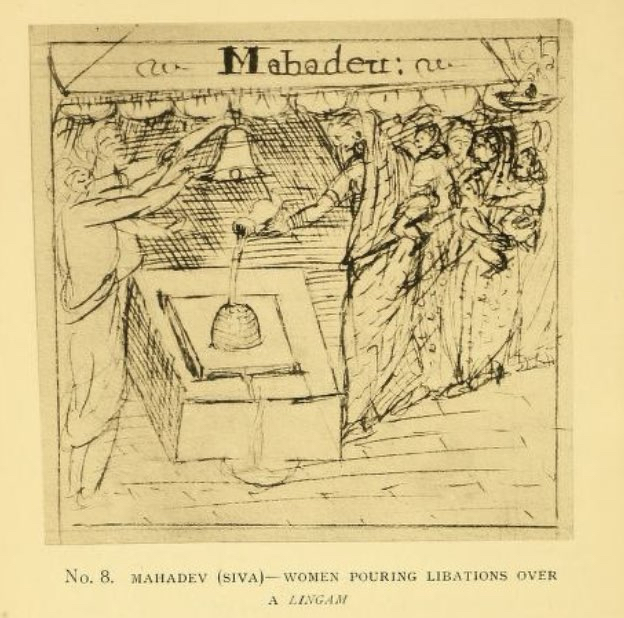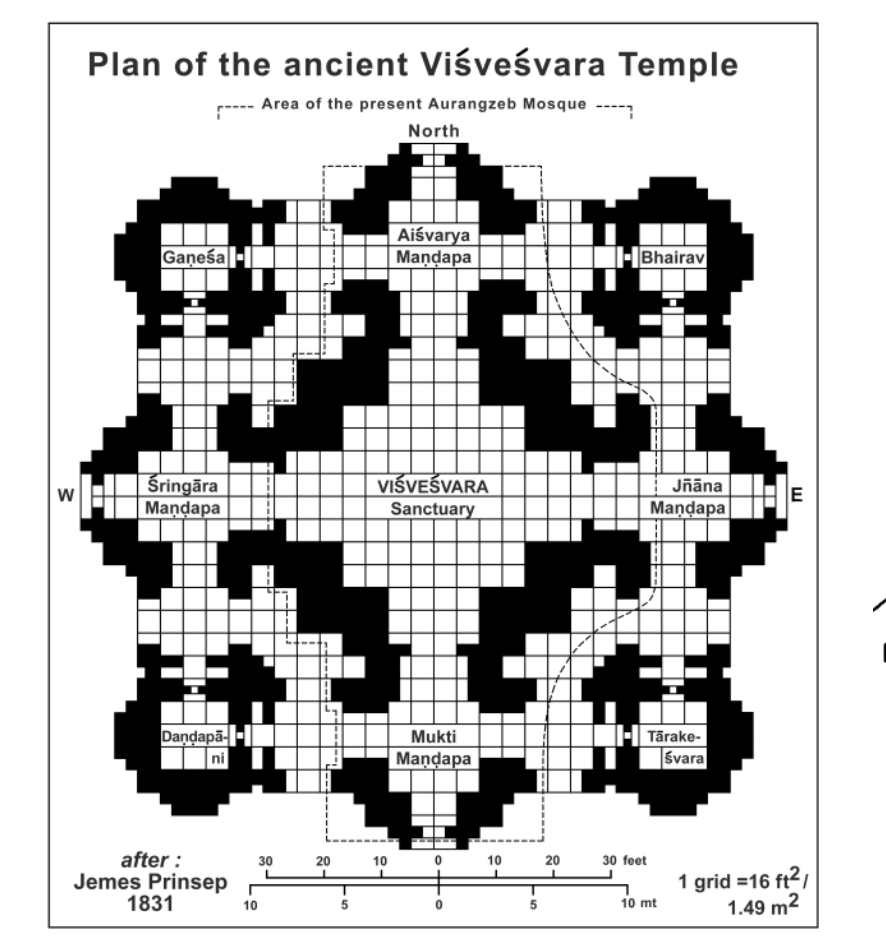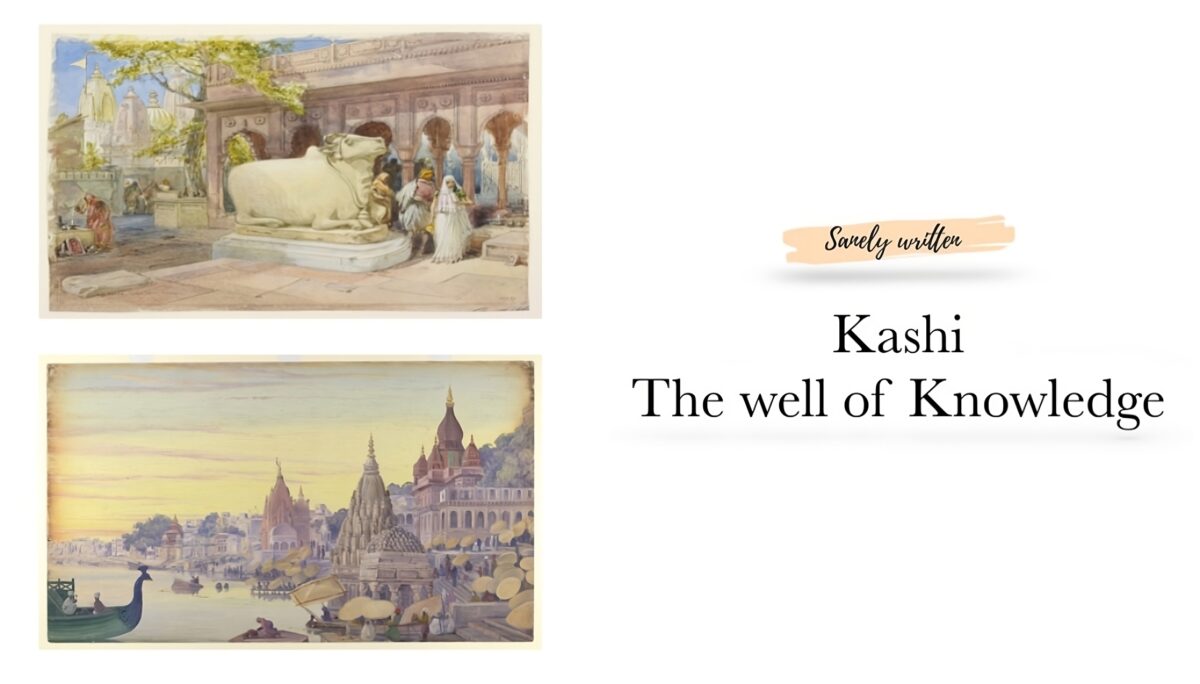“When Babylon was struggling with Nineveh for supremacy, when Tyre was planting her colonies, when Athens was growing in strength, before Rome had become known, or Greece had contended with Persian monarchy, …. She had already risen to greatness, if not glory.”
Matthew Atmore Sheering writes about the glorious and the oldest surviving city of human civilisation in his book The Sacred City of Hindus: An Account of Benares in Ancient and Modern Times. The aforesaid statement by Sheering crisply points out the significance of the city of Varanasi not only for Bharat but the entire world. The word Kashi comes from the Sanskrit word ‘kash’ or the one that shines. When the morning rays fall on the flowing expanse of the Ganga river, the city on its banks illuminates, which aptly justifies the name Kashi. Known by various names flowing through different eras in time, Kashi signifies the very fabric of the Indian civilisation. Kashi, Varanasi, Banaras, Avimukta, Ananda Vana, Rudravasa, and Mahasmashana are just a few names by which this city has been known spanning over a time period which is very hard to describe.

Shiva, the supreme being and one of the triumvirate of the Sanatana Dharma, is said to be the presiding deity of the city. “Kashi ke kankar kankar me Shankar hai” (In every stone of Kashi, Shiva resides).
According to the Kashi Khanda, a celestial being by the name of Ishana had come to the city of Kashi and was astonished by the beauty of a linga that he found amongst all the foliage. He was so mesmerised by its grandeur that he decided to bathe the linga with pitchers of water. Not satisfied by the presence of the water bodies around the linga he decided to create one of his own. With his trident, he struck the ground which created a deep pit and out came gushing water which was cold as snow and white as sparkling moonlight. He used thousands of pitchers of this water to bathe the linga. Lord Shiva, pleased by this gesture, appeared in front of him and showered him with a boon. A humbled Ishana requested Mahadeva that this place be revered as a tirtha kshetra which was instantly granted. In addition, the stream of water that was oozing out of the ground was also imbued with magical powers by Shiva. He mentioned that his name Shiva meant knowledge and here, knowledge was present in liquified form. So he blessed that stream of water which became a well and would be available to the devout eternally. The place was to be called the “Jnana tirtha” or the centre of knowledge and the well was termed as “Jnana-Vapi” or the well of Knowledge.
As one walks through the narrow streets of Kashi, one would find several small and big shrines where the devout is worshipping a Shiva Linga. There is a plethora of lingas with different stories of their inception. In one of the passages in Kashi Khanda where Shiva talks to goddess Parvati, he says, “…once they were counted as a hundred Parardhas (Parardha = one followed by seventeen zeroes.) Sixty crores of lingas are stationed within the waters of Ganga. O goddess, those Siddha lingas have become invisible in this Kali age.” The importance of a Shiva linga in Kashi is a no-brainer but there are several of them that hold an edge. Shiva, according to the Kashi Khanda, lists fourteen of the most important lingas in Kashi.
Omkareshwara, Trilochana, Mahadeva, Krittivaseshwara, Ratneshwara, Chandreshwara, Kedareshwara, Dharmeshwara, Vireshwara, Kameshwara, Vishwakarmeshwara, Manikareshwara, Avimukteshwara and Vishwaeshwara.
Amongst many other lingas is the primary Jyotirlinga named “Vishweshwara” or “Vishwanatha” which means the lord of the universe. But even within the vast number of lingas there, the Kashi Khanda clearly emphasises the importance of Vishweshwara in the voice of Mahadev Shiva himself, “There is no linga equal to that of Vishwanatha. There is no tirtha other than Manikarnika.” The Vishweshwara Jyotirlinga was often called the ‘people’s linga’ and was one of the reasons for its popularity amongst the devout. It had no sparsh dosha, meaning, any male could touch the Shiva linga while worshipping.
But the glory of Kashi or Banaras, as the people refer, was to see a downfall that would scar the beauty of this divine land that still has not been washed off and stare at our faces as one walks around plot no. 9130.
THE DOWNFALL:
The invasion of Sindh marked the beginning of a thousand years of bloodied massacre, ransacking of temples and proselytisation of Hindus un-masse. Nasir ad-Daula Sabuktigin, a slave officer of the Samani dynasty had broken away and had formed his own Ghaznavid dynasty. He along with his son Mahmud (Sultan Mahmud of Ghazni) had taken upon themselves for the propagation and the Turkish conquest of Hind (India). We are well aware of what took place on the holy site of Somnath in Gujrat, and numerous evidences coincide to disprove the Marxist historian’s claim of Ghazni being a liberator of the enslaved so-called “lower-caste” people from the clutches of the “evil” Brahmin priest of the temple (Can be explored in some other blog).
Ahmad Nialtagin, the treasurer of Mahmud, knocked on the doors of Kashi in 1033 CE thus, starting the first invasion of Kashi. He was there for a few hours, mostly for the treasures of the city and left with tons of Gold and silver and demolishing some places of Hindu worship, but the damage was limited.
Eventually, between 1034-35, Syed Salar Masud, nephew of Mahmud, took his permission to attack India to spread Islam. He invaded India but faced a tough battle in Bahraich, where he was killed, but a portion of his army under Malik Afzal Alvi, reached Varanasi. The invading army faced some resistance in which the commander was killed. The site of this battle is believed to be the same place where the Masij-e-Ganj-e-Shahidan stands near the Kashi Railway station. Honouring the Hindu Tradition, the civilians that accompanied the army were allowed to settle in a forest region in the north of the town. Later that place was termed as Alvipura (Alai Pura).
The final blow came down on Kashi in the name of Qutub-ud-din Aibak, the military commander of Mohammad Ghori in 1194 CE. He was confronted by Jayachandra of the Gahadavalas in Chandawar. Multiple historical accounts give different pictures as to how the battle took place but eventually ended with King Jayachandra being killed and huge amounts of wealth being taken away from the land. Hasan Nizami writes in Taj-ul-Masir that after slaying the Hindu King Jaya Chand the army charged into the city of Benares and destroyed nearly 1000 temples of the kafirs and raised mosques on their foundations. Once Qutub-ud-din took the throne of Delhi, Varanasi was totally levelled along with the destruction of Sarnath. The message was loud and clear from the very inception of the Muslim invasion, they were here to loot, kill and convert.
Slaughter and carnage of this magnitude could easily inflict decades of fear amongst the masses, but to the historical surprise, what followed is a story of sheer stubborn resolve, persistence and devotion of the Hindus. Demolition of the structure did not remove the sense of devotion that generations of Hindus had in their hearts for the place where the structure once thrived. They were of the mindset that the place where the linga once stood was also sacred and that spot should be worshipped. The coming years showed how even after multiple attacks on the holy land of Hindus did not deter their faith and temples kept resurfacing either on the same site or in the premises.
A few decades later, a businessman from Gujarat, Seth Vastu Pal had donated a hundred thousand rupees for the construction of a grand temple of Vishwanath. In another incident, around 1250-60, Veer Narasimbha III had donated a whole village saying that whatever revenue would be generated from this village would be used to pay the Jaziya tax that was taken from the Hindus for their pilgrim travel. These are just a few incidents amongst many more to prove that Kashi Vishwanath had its significance to the people all around the country.
Years passed by and rulers kept changing but the attitude of each one of them towards the kafirs was the same. But the devout Hindu kept on worshipping in the exact spot where the grand temple once stood. They would sneak in and out when the guards would not watch and offer their prayers on the premises of the razed Shiva temple. Not just Kashi, temples all around the country were demolished and mosques were constructed. Between 1236 to 1240 CE, Raziya Sultan constructed a Mosque in Kashi which is known by the name Raziya Mosque. In 1376 CE, Firoz Shah Tuglaq constructed the Atala Mosque in Jaunpur by razing down the Atala Devi temple constructed by Jayachandra. How empathetic of the “noble” Muslims to take the same name for the mosque as the temple before it.
Amongst the many who reconstructed small and large Vishweshwara temples in Kashi and kept the flame of the Hindu faith burning, the contribution of Narayana Bhatta (1514- 95 CE) has to be mentioned. Narayana Bhatta was a very revered scholar who is credited for composing several notable works like the Tristhali Setu, Prayoga Ratna etc. He was honoured by the title of Jagadguru, the preceptor of the universe.
This was the time of Akbar whose reign witnessed some breathing gaps for the Hindus. The second half of his reign saw many signs of relief for the Hindus as many temples were constructed under his influence. One of the reasons for this gesture was his relations with the Rajput rulers of Jaipur and especially with Raja Man Singh of Amber. By that time Narayana Bhatta had earned a huge name for himself and was revered to have mystical fame by then. Raja Todar Mall, one of Akbar’s ministers also managed his finances. Multiple accounts have different stories as to how things got into place but inspired by Narayana Bhatta’s scholarship and his name, Todar Mall took to Akbar the task of constructing a Vishweshwara Temple at the site of demolition. Receiving a go by the emperor, after 89 long years, a grand temple was constructed in 1585.
The grandeur of the newly constructed temple is portrayed by the lithograph prepared by James Prinsep (1799-1840) and is one of the only sources of authentic information available that depicts the architectural plan of the temple. James Prinsep was an English Scholar who founded the journal of the Asiatic Society of Bengal and is also revered for deciphering many Kharosthi and Brahmi scripts.

The short-lived period of peace ended as Akbar was succeeded by his grandson Shah Jahan. All temples that were constructed by the orders of Akbar (76 in Benaras alone) were destroyed again. But the final blow for Vishwanath was yet to come, and that took the face of Aurangzeb, his son.
Coming to power, within just a year he ordered the demolition of the famous Shiva temple in the heart of Kashi- the Shiva temple of Krittivaseshwara situated in Daranagar and in its place the Alamgir mosque was constructed. Aurangzeb had taken it upon himself to carry out jihad against the Hindus and spread Islam. Some unverified sources also claim that Aurangzeb had sent in an army in 1664 to bring down the Kashi Vishwanath but they faced a very brutal resistance by the naga sadhus of Mahanirvani Akhara of Varanasi. The Masir-i-Alamgiri, by Saqi Mustaid Khan, which accounts for nearly five decades of Aurangzeb’s rule, provides a brief description of how Aurangzeb, upon hearing that the Brahmins in Kashi were spreading their ‘false religion,’ immediately ordered the destruction of all Hindu places of worship.
“On the 15th Rabi-ul-akhir (2 September 1669), it was reported to his religious majesty, leaders of the unitarians, that in obedience to order, the Government officers had destroyed the temple of Bishnath (Vishwanath) at Benares”.
But the western part of the temple was partially destroyed to spite and shame the Hindus for years to come. This was done purposely so that the mosque could be a site of utter humiliation for the Hindus who would see it and feel helpless every single day for the rest of their life. The mosque constructed was named the “Gyan Vapi Mosque”, an irony of a name owing to its Sanskrit nomenclature. Later in the blog, we will factually prove how the Mosque itself, putting aside all other arguments favouring both sides of the argument, is an illegal construction according to the rules of Islam. But as explained above, any means of the barbaric Muslim rulers and their numerous attempts to destroy our temples did not affect the resolve of the Hindus. This itself disproves the narrative of the tolerant Hindu who will silently accept everything and anything done to its faith system. As temples kept falling, newer ones kept building and the resolve kept getting stronger. An interesting incident is mentioned in Persian literature about a person named Chandrabhan, a Brahmin in Shah Jahan’s court who silenced the emperor by saying that even if you take me to Kabba a hundred times I will still return a Brahmin.
After the death of Aurangzeb in 1707, the Mughal power started to deter and the Marathas took a rise. Their resolve to take control of their Hindu shrines from the clutches of the Mughals was also growing. The chief of Indore Malhar Rao Holkar wanted to demolish the Gyan Vapi Mosque and rebuild the Kashi Temple over it. Eventually, the task of building a roof over the shrine that had resurfaced just next to the Mosque in Kashi fell over the shoulders of Maharani Ahilya Bai Holkar, the daughter-in-law of Malhar Rao.
During the thirty years of her reign, Indore saw a period of peace and prosperity. She also took it upon herself to liberate Hindu shrines not only in Indore but also around the country. She gave numerous grants to people for building new shrines and maintenance of the existing ones. Aurangzeb during his reign had destroyed numerous places of worship and Ahilya Bai took the responsibility for reconstruction of them across India. Shaivite and Vaishnavite and even the twelve jyotirlingas, the char dhams all are beneficiaries of her benevolence and quite naturally at Kashi as well, a small temple was constructed in 1777 over the linga that was being worshipped by the devout ever since it was destroyed by Aurangzeb, as one can clearly see, the faith and resolve was not at all shaken. The temple was obviously not as grand as the one constructed by Narayana Bhatta, it was a fairly small structure about 50 feet square. Matthew Sheering in his work writes,
“It seems clear, that, for the most part, the emperor forbade the Hindus to build spacious temples, and suffered them to erect only small structures of the size of cages for their idols, and these of no pretensions to beauty”. “….the probability is that they were taken from the ruins of the old temple of Bishshwar, which stood to the north-west of the present structure, and was demolished by the Emperor Aurangzeb … extensive remains of this ancient temple are still visible. They form a large portion of the western wall of the Mohammedan mosque, which was built up in its site by this bigoted oppressor of the Hindus”.
The eminence of Kashi was all over India and can be seen by the fact that Maharaja Ranjit Singh got the spines and the domes of the temple plated with gold in 1839. The temple that now stands in Varanasi is the same temple built by Maharani Holkar.
Lath Bhairav riots, Peaceful community:
Madhu Rai, a Hindu who lived around a place thriving with a Muslim population. He had fallen ill and made a plea to his Bhagwan lord Hanuman that if he helped him get rid of this illness, he would take it upon himself and have the mud-shrine of Hanuman which stood under a peepal tree next to the Vishwanath temple and make it into a permanent one of stone. Eventually, his health got better, but the only problem was that the Hanuman temple was common to the Kashi Vishwanath temple and the Gyan Vapi mosque compound.
A few weeks later, when the Hindus went to worship the Kapildhara, they found a cow slaughtered there and the blood was spilled all over the place. The matter was taken to the police and the man responsible was taken into custody but was later bailed. But the peaceful community was not done yet.
The construction of the stone wall over the Hanuman temple was taken seriously by them which invited opposition. The chief amongst them were Dost Mohammad and Fateh Mohammad. By the evening of 19 October 1809, a large gathering of Muslims started marching towards the disputed area. Soon after, some men along with Dost Mohammad sneaked into the area. The pedestal on which Hanuman was seated was tilted over, the tulsi plant was uprooted and the Lath itself was beaten up by shoes. The Hindus upon finding out this incident and seeing the horrors themselves decided to take revenge. They were enraged and a large Hindu mob went on the road and they decided to bring down the Gyan Vapi Mosque once and for all. Fearing a bloody riot, the then-acting magistrate W. Bird decided to intervene and urged the Hindus to stand back, which they eventually did.
By then new news came out that the Rajputs had marched towards the imambara and they had beaten up the local maulvi and the holy book was also torn. Hearing this, an enraged Dost Mohammad gathered around 7000 to 8000 Muslims and decided to break down the Kashi Vishwanath Temple. The Hindus too gathered for the protection of their sacred place and as one can imagine, a riot took place which was fairly one-sided as the julaha muslims were of no match to the skilled Rajput fighters. Around 100 Muslims were killed in these riots and as a result, Dost Mohammad decided to back down and he fled the battlefield. While the Hindus were protecting the Kashi temple, the original dispute site, the Lath Bhairav was left uncovered and an enraged Dost Mohammad decided to break down the Lath into different pieces. A local cow was also dragged out from a house and was butchered there and the blood was splashed over all the sacred places of the Hindus and also into the holy tank of Bhairav.
The Muslims felt victorious at first but they still feared the repercussions of their actions. The next day, without beating around the bush, the Hindus set the Gyan Vapi Mosque on fire and destroyed around a hundred different mosques all around Kashi, several were brutally killed. The whole incident of killings went on for a few days but eventually, peace was restored after several negotiations.
After the year 1854 there occurred a number of incidents and several court orders were issued that showed that the Hindus and the Muslims kept accusing each other of encroachment into their territory. Pity issues like leaves of the tree standing on the Temple side falling towards the Mosque area. There was a case in court in 1852 where a dispute arose between Amanat Ali and Mahadev Vyas to decide who should be allowed to cut down an old pipal tree that had a shrine of Veerbhadreshwara under it. Several other cases were also taken to court but what is interesting here is the fact that several inspections took place of the entire area and numerous documents were scanned for various cases pertaining to which, the court had directed Amanat Ali twice that the property did not belong to the Muslims.
The issues regarding the ownership of parts of the temple and Mosque only increased and it started intensifying after 1925. Muslim overcrowding for offering prayers in the Mosque often led to disturbance to the Hindu side who used the passage to offer the parikrama. Several orders were given to them for not using the walking passage for offering namaz but as we can see today as well, sitting on roads and creating deliberate nuisance for the general public has been the idea all along.
The issue of the Gyan Vapi mosque has intensified as we write this blog. The court-ordered archaeological survey by the ASI has been carried out and the report is available for the general public with a very clear statement that a temple existed before the construction of the Mosque. But this story is not that simple. In the next part of this blog, we will dive deep into the legal argument of both parties and also shower some light upon the Places of Worship Act of 1991 and what role this act has in this whole story and try to find the way forward.
Reference/s:
- Waiting for Shiva: Unearthing the Truth of Kashi’s Gyanvapi by Vikram Sampath
- The Kashi Vishvanatha, Varanasi city, India: Rana Construction, Destruction, and Resurrection to Heritagisation by Rana P.B. Singh and Pravin S. Rana
- The Travels of Peter Mundy in Europe and Asia, 1608-1667 by Peter Mundy
- Tracing the Past of Kashi Vishwanath Temple by Mahesh Gogate




2 replies on “Kashi: The well of Knowledge”
very informative blog…..
अत्यन्त सुन्दर ज्ञान , जिसका अभाव हम लोगों को धार्मिक रूप से कमजोर और रुग्ण बना रहा है